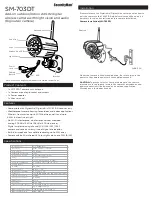
DSP-22-1 User Manual
Page 15 of 22
DSP-22-1_MAN_D
of square feet in the loop (length times width in feet). If you are unsure about your particular installation, call tech
support for guidance.
Loop Size in Square Feet Recommended Turns
for
<100’ of Lead
-in
Recommended Turns for
100’ to 199’ of Lead
-in
Recommended Turns for
200’ to 299’ of Lead
-in
5 to 6 square feet
7
8
10
7 to 9 square feet
6
7
9
10 to 15 square feet
5
6
8
16 to 23 square feet
4
5
6
24 to 54 square feet
3
4
5
55 to 150 square feet
2
3
3
Installation Practices:
Permanent loops should be installed into the road surface by cutting slots into the road
surface using a saw with an appropriate cutting disk for the road surface.
The slot cut should be wide enough that the wire being used will easily fit into the slot. This is needed so that the
loop sealant used can fully encapsulate the wire. When the wire fits tightly in the slot, the sealant may not be
able to get below the wire, leaving air pockets in the saw slot. If water finds its way in to these air pockets, over
time, freeze thaw cycles can slowly jack the loop out of the saw slot causing loop failure.
The saw slot should be deep enough that the loop wire will have a mi
nimum of ½” of sealant over the top wire in
the slot. More is better. Going too deep with the saw cut is also a concern. Deep cuts in a road surface may
impact the structural strength of the roadway, especially if any reinforcement material is cut. Using a smaller
gauge of wire will allow for shallower saw cuts.
The corners of the loop should be crosscut at a 45
°
to help prevent damage to the wire insulation during
installation and temperature cycling. The angled cuts should be at least 9” back from w
here the corner would be.
The saw cuts should not go any further than necessary to ensure that the saw slots are at full depth where they
meet.
Special consideration should be given to where the home run saw cut meets the loop saw cuts. Here either an
additional saw cut should be made as shown in Detail A or the inside of the sharp corner should be removed with
a chisel as shown in Detail B.
Once the saw slot has been cut, the slot should be cleaned of all loose material. High-pressure air should be
directed in to the saw slot to remove all debris. This will also help remove dust from the saw cutting operation
from the sides of the saw slot. This will allow better adhesion of the loop sealant to the saw slot.








































